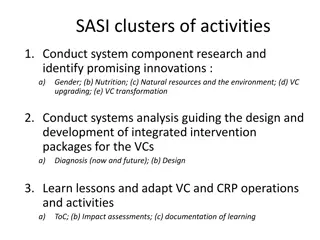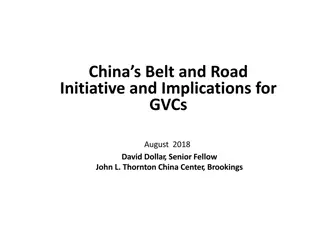Assessing Economic Impact of Global Value Chains
Global Industry-level Production Accounts framework evaluates benefits and risks of global value chains on productivity and competitiveness. Explore implications through empirical data analysis for Canada, the US, and other countries.
Download Presentation

Please find below an Image/Link to download the presentation.
The content on the website is provided AS IS for your information and personal use only. It may not be sold, licensed, or shared on other websites without obtaining consent from the author.If you encounter any issues during the download, it is possible that the publisher has removed the file from their server.
You are allowed to download the files provided on this website for personal or commercial use, subject to the condition that they are used lawfully. All files are the property of their respective owners.
The content on the website is provided AS IS for your information and personal use only. It may not be sold, licensed, or shared on other websites without obtaining consent from the author.
E N D
Presentation Transcript
Global Industry-level Production Accounts: A Framework for Assessing the Economic Impact of Global Value Chains on Productivity and International Competitiveness Discussant: Catherine Van Rompaey, World Bank The 38thIARIW General Conference August 26-30, 2024 Session 7D-2
Global value chains: benefits and risks In recent decades, supply chains have been extended across international borders and over greater distances. Before the COVID-19 pandemic, globalization and participation in global supply chains were often associated with economic benefits such as higher productivity and higher wages. However, the pandemic and its aftermath have highlighted the risks associated with global supply chains, such as acute shortages of essential goods, disruptions to domestic production of goods, and higher inflation. Statistics Canada and its federal partners have been devoting efforts to improve supply chain measurement and statistics on the risks and benefits of the global production. 2
The objective of the paper Examine the benefits of global value chains using the global production accounts proposed by UN (2019) and Samuels and Strassner (2019) Propose measures of productivity and international competitiveness for examining the benefits of the global production Present an empirical application of the approach for Canada, US and several other countries 3
Outline Present the global production account Derive the measures of productivity and international competitiveness Provide an empirical application and estimate the effect of global production on productivity for Canada and several other countries using the data from EUKLEMS and OECD ICIO Conclude and questions for the author 4
Global production account The key to examining the economic effects of global value chains is to recognize the inter-linkages of production activities among industries and countries. The global production account is a framework for presenting this inter-linkages and for organizing statistics on the risks and benefits of global value chains in a consistent manner. 6
Global production account The foundation of the global production account is the global supply use tables (SUTs), the global multi-country KLEMS industry-level productivity accounts, and a set of purchasing power parities for outputs (gross output and value added) and inputs (capital, labour and intermediate inputs). 7
Country A Country B RoW C Country A Country B RoW C Total Intermediate Intermediate Intermediate Final Final Final Industry Industry Industry Domestic Domestic Domestic Country A Intermediate use Intermediate use Intermediate use Final use of Final use by B Final use by Output in Industry of domestic by B of exports by C of exports domestic of exports from C of exports A output from A from A output A from A Country B Intermediate use Intermediate use Intermediate use Final use by A Final use Final use by Output in Industry by A of exports of domestic by C of exports of exports of C of exports B from B output from B from B domestic from B output Intermediate RoW C Intermediate use Intermediate use Intermediate use Final use by A Final use of Output in Industry by A of exports by B of exports of domestic of exports use by B of domestic RoW from Row from RoW output from Row exports from output RoW Value added: Value added: Value added: Capital and Capital and Capital and labour input labour input labour input 8 Output in A Output in B Output in RoW
Measures of productivity and international competitiveness Multifactor or total factor productivity (MFP, TFP) is measured as output per unit of combined labour and capital inputs. It measures the efficiency with which industries and firms transform inputs into outputs. TFP can be measured either in level or growth terms. International competitiveness is measured as the price of an industry s output in one country (e.g. Canada) relative to the price in another country (e.g. the United States) (Jorgenson and Kuroda, 1991). This relative price level index is defined as the ratio of the purchasing power parity to the market exchange rate. 10
Two approaches for examining the effects of global value chains Traditional growth accounting approach where an industry is considered in insolation. An integrated approach where all industries involved in the production of a product are considered as an integrated production process (Domar 1961, Hulten 1978, Gu and Yan, 2017 and Timmer, 2019) 11
Traditional growth accounting: productivity growth According to the traditional growth accounting: the growth in gross output can be decomposed into various components extended here to include imported intermediate input : contributions from labour input, contribution from capital input, contribution from intermediate inputs domestically produced contribution from intermediate inputs imported, and MFP growth. Eldridge and Harper (2010) show that imported intermediate inputs made a significant contribution to labour productivity growth in the U.S. The growth in imported intermediate inputs contributed 14 percent to the annual growth in labor productivity for the U.S. private business sector, and 23 percent to the average annual growth in labor productivity in the U.S. manufacturing sector from 1997 to 2006. 12
Traditional growth accounting: productivity level The output level difference in two countries is decomposed into: the difference in the level of capital, labour and intermediate inputs (domestic and imported) in the two countries, and the relative MFP level differences in the two countries. Inklaar and Timmer 2009 and Hofman et al, 2022 provides a more recent application of this approach. 13
Traditional growth accounting: price competitiveness The relative price level index of industry output or international competitiveness between two countries can be examined using the dual to the growth accounting equation (Diewert, 1976; Diewert and Fox, 1997). The relative price level index of an industry output is decomposed into: the relative price level indices of capital input, labour input, intermediate inputs domestically produced, and intermediate inputs imported, and the relative level of TFP. Jorgenson and Kuroda (1991) applied this approach for U.S. and Japan comparison. 14
Integrated approach: productivity growth The production of a product is defined as an integrated production process that includes all stages of production. MFP growth for the production of an output can be calculated as the difference between the growth in output and the growth in the combined capital and labor inputs used directly and indirectly (or total capital and labour inputs) to produce the output. Hulten (1978) calls this measure an effective TFP measure. Gu and Yan (2017) applied this approach. 15
Integrated approach: productivity growth Effective MFP growth for the production of an output is the weighted sum of standard MFP growth across sectors in all countries, where weights equal to the total production values of a sector in a country for the production of one unit of the output. The MFP growth can decomposed into a portion coming from domestic industries and a portion coming from foreign industries. Gu and Yan (2017) show that the effective MFP growth is equal to standard MFP growth in a closed economy. 16
Integrated approach: productivity level The relative total factor productivity (TFP) level of the integrated production of an output in the two countries is measured as the output differences in the two countries, which are not accounted for by differences in total capital inputs and total labour inputs between two countries. 17
Integrated approach: competitiveness The relative price level index of output in the integrated production process between two countries can be examined using the dual approach to growth accounting. The relative price level index of industry output between two countries is decomposed into the relative price level index of total capital input and total labour input, and the relative level of TFP. 18
Empirical application The empirical section will focus on the integrated approach for assessing the effect of global value chains on productivity growth. The analysis on TFP levels and price competitiveness using the integrated approach will be possible when a full set of PPPs for output and inputs are developed from EU KLEMS and other initiatives such as LA KLEMS. 20
Data sources OECD Inter-Country Input-Output (ICIO) tables, for 45 industries and 76 countries (and Rest of the World) from 1995 to 2020 EU KLEMS (Bontadini, et al. 2023), for 27 European countries, United Kingdom, United States and Japan across 42 industries and 15 industry aggregates for 1995-2020 Canadian KLEMS data are from Statistics Canada China KLEMS data are from the China Industrial Productivity (CIP) Database (Wu et al, 2023) The industries in various data sources are aggregated to a common set of industries (28). 21
Empirical results The estimates are presented for 6 countries or regions: Canada, US, Japan, China, UK and EU19 for three periods: 1995 to 2000, 2000 to 2010 and 2010 to 2019. Data for EU are only available for the recent period 2010 to 2017. This presentation will focus on the most recent period 2010 to 2019. 22
The evidence on global integration Canada U.S Japan China UK EU19 ROW Canadian and U.K. industries are highly integrated with the global production: 21% of intermediate inputs are imported for Canada; 17% for UK in 2019. The U.S. accounted for about half of Canada s intermediate input imports, while Canada contributed 15.1% of the U.S. intermediate input imports. The share of imported intermediate inputs from China rose in all countries and regions from 2000 to 2019. The share increased from 2% to 11% for Canada; from 4% to 13% for the United States; and from 3% to 9% for the EU. 2019 Share of imports in 21.42 8.16 13.88 7.37 17.42 14.17 9.94 intermediate input in (%) Share of imported intermediate inputs by country (%) Canada 15.08 1.58 1.62 2.21 1.18 1.71 U.S 52.55 13.59 6.20 13.73 15.49 21.22 Japan 2.52 4.77 7.38 2.31 3.84 8.31 China 10.51 12.85 15.14 6.66 8.82 27.99 UK 2.02 4.74 1.87 1.21 10.13 4.48 EU19 10.56 15.74 10.67 10.62 42.39 36.28 ROW 21.85 46.82 57.15 72.97 32.70 60.54 23
Standard and Effective MFP growth The effective MFP growth can be different from the standard measure of MFP growth. For Canada s total economy, effective MFP growth was higher than standard MFP growth for all three periods, as productivity growth in intermediate inputs in the US tend to be high. Effective MFP growth was higher than standard MFP growth in China for all three periods, as productivity growth in intermediate inputs in the developed countries that China imports from tends to be relatively high. Standard and Effective MFP growt (% per year), 2010 to 2019 0.80 0.72 0.64 0.60 0.51 0.34 0.40 0.29 0.27 0.22 0.16 0.20 0.12 0.12 0.00 -0.12 -0.20 -0.28 -0.40 Canada U.S Japan China UK EU19 Standard MFP Effective MFP 24
Country origins of productivity growth through global value chains, 2010-2019 Canada U.S Japan China UK EU19 Domestic gains were the main driver of productivity growth, But productivity growth in foreign countries made a significant contribution. For example, between 1995 and 2000, 0.60 percentage points or 70% of the 0.87 percentage point annual growth in MFP in Canada was domestic, and about 0.24 percentage points or 28% came from productivity growth in the United States. While there is an increasing trend towards sourcing intermediate inputs from the countries such as China with relatively low costs in the developed countries, the share is still relatively modest overall. Therefore, the contribution of China to productivity growth in Canada and other developed countries was still small. MFP growth (% 0.51 0.16 0.72 -0.12 0.27 0.12 per year) Contribution by country in percentage points Canada 0.44 0.01 0.00 0.00 0.00 0.00 U.S 0.02 0.12 0.00 0.00 0.01 0.01 Japan 0.00 0.00 0.69 0.01 0.00 0.00 China 0.03 0.02 0.03 -0.13 0.02 0.02 UK 0.00 0.00 0.00 0.00 0.23 0.00 EU19 0.00 0.00 0.00 0.00 0.00 0.08 ROW 0.00 0.00 0.00 0.00 0.00 0.00 25
Country origins of TFP growth for highly integrated industries an example for Canada , 2010 to 2019 For those industries that are highly integrated in the global production such as the auto, and computer and electronic manufacturing in Canada, productivity growth are highly dependent on the growth in the production of intermediate inputs in the United States and other countries. Industry MFP Contributions by country in percentage points (% per Can U.S Japan China UK EU19 year) Computer and electronic product 0.93 0.50 0.14 0.02 0.26 0.00 0.00 manufacturing [334] Electrical equipment, appliance and 0.60 0.38 0.08 0.01 0.13 0.01 0.00 component manufacturing [335] For example, for computer manufacturing, about half of productivity growth (0.43 pps out of 0.93%) is from efficiency gains in the production of intermediate inputs (chips) in other countries. Transportation equipment 0.68 0.45 0.13 -0.01 0.10 0.00 0.00 manufacturing [336] 26
Conclusions This paper presents two approaches for examining the effect of global value chains on productivity and international competitiveness using the global production account: traditional growth accounting and integrated approach. The integrated approach provides a more comprehensive analysis of the effect of global value chains. The paper demonstrates the importance of global value chains for productivity growth for open economies (such as Canada) and for industries that are highly integrated in global production (such as auto manufacturing and computer and electronic product manufacturing in Canada). 27
Future work Global production is also expected to improve the competitiveness through access to relatively lower costs of labour and intermediate inputs in developing countries. This paper has proposed a method for examining such effect which can be implemented when the set of PPPs for output and inputs in the global production account are developed through ongoing work. 28
Questions for Author What are some examples of ongoing work on the measurement of the global supply chains in Canada? What are the major challenges for implementing the global production account proposed by UN? 29























